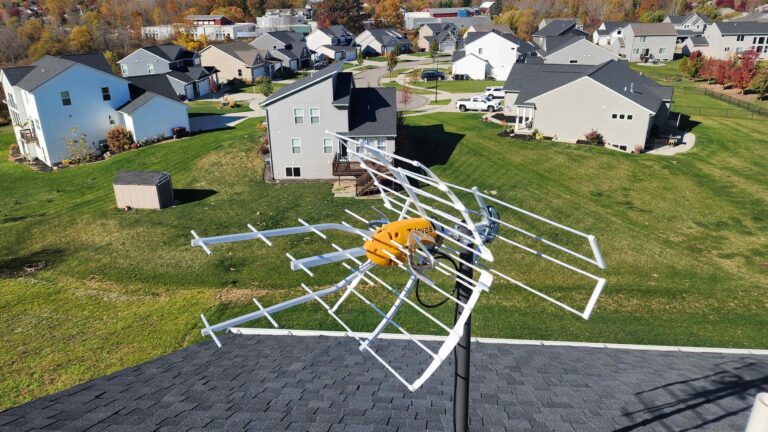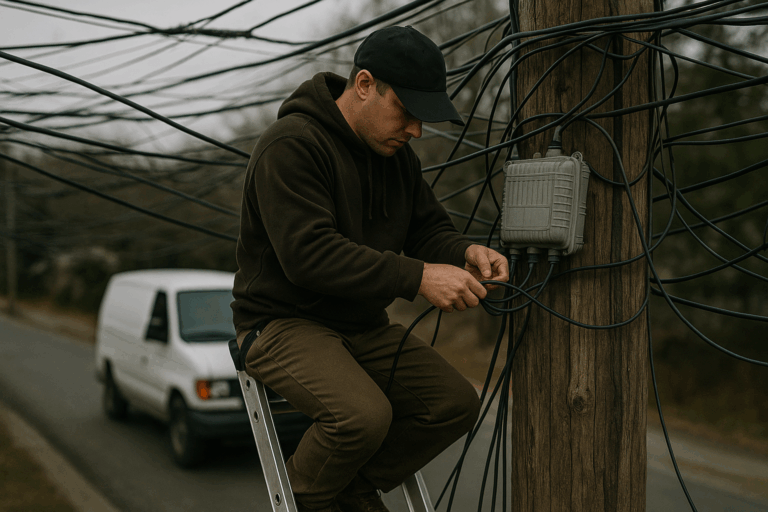HOAs, Landlords, and Your Right to an Antenna
The other day, while helping a customer in Byron Center, I encountered a familiar question before the antenna installation: “Hey, doesn’t my HOA need to approve this antenna?” I have to smile every time I hear this (it’s a great question!)—because HOAs and landlords actually lost that battle back in 1996! Well, kind of. ****
The asterisks (*) are the catch—not the expletives homeowners might shout after a dispute about “exclusive” vs. “common” space. The Federal Communications Commission (FCC) took the remote control out of their hands nearly three decades ago when it comes to antenna installations in “exclusive-use” areas. If you want free local TV or satellite internet, the only permission you need for a single-family dwelling is your own (and a good antenna installer 😉). Yes, this includes Starlink and other satellite internet users. Just be sure you know the difference between your “exclusive-use” areas and the “common-use” shared spaces in condos or multi-family rentals.
Here’s the deal: In 1996, the FCC implemented the Over-the-Air Reception Devices (OTARD) rule (47 C.F.R. § 1.4000) to stop HOAs, landlords, and property managers from restricting antennas for TV, satellite, and certain fixed wireless services. The rule covers antennas less than 39 inches (or any size in Alaska) and lets homeowners or tenants install them on property they control—whether that’s a patio, balcony, or deck. And let’s be honest, no one wants to see 16 foot antennas all across the roofscapes of their neighborhood. That’s why the 1 meter law exists; it’s a happy medium and allows for smaller aerials to tuck away better, yet still work. And note that condo and duplex rooftop antenna installations in HOA controlled areas can fall under a shared space and might need approval. Read on…
Images of My HOA Installations
Who’s Affected by the OTARD Rule?
-
Single-Family Homeowners
: If you own a single-family house or have an exclusive-use space, like a roof or yard, you’re good to go.
-
Renters
: As long as you have an exclusive-use area—like a balcony or private patio—you can install an antenna.
-
Condos and Co-ops
: The rule applies to residents in townhomes, condos, or manufactured homes if the antenna is placed in a space only they control (your patio, balcony, deck, and usually attic).
Landlords or HOAs cannot block your installation unless they meet very specific safety or historic preservation criteria. For example, they can’t ban antennas just because they don’t like the look of them. Condo owners and renters, it’s very important, however, to understand that you can install antennas in “exclusive use” areas like a balcony, but not “common use” locations such as a roof. In contrast, if you’re a homeowner and don’t live in a shared building, then you can install a rooftop antenna without HOA permission, as long as you follow the FCC guidelines. (Federal Communications Commission) (Hirzel Law)
Why Did the FCC Get Involved?
The FCC wasn’t just being nice—it stepped in for serious reasons. Back then, some HOAs were blocking TV antennas, making it hard for people to receive local broadcasts. This meant homeowners could miss out on emergency alerts and weather updates. Imagine living in a community where a tornado’s coming, but you miss the broadcast because your HOA thinks antennas are ugly! The FCC said, “Nope, not happening,” and the OTARD rule was born.
Here’s What You Need to Know About the OTARD Rule
- HOAs Can’t Stop You: They aren’t allowed to ban or delay your antenna installation without a valid safety reason. (no board meetings necessary)
- No Costly Red Tape: They can’t enforce approval costs or drown you in approval forms.
- Signal Quality Matters: HOAs can’t interfere with your ability to get clear reception from local stations.
- Safety and Historic Preservation: They can only restrict antennas if there’s a legitimate safety risk (like a poorly secured antenna flying off the roof, towers, large antennas bigger than 1 meter) or if the area has historical preservation status. Keep this in mind when moving forward.
What the OTARD Rule Covers
The OTARD rule applies to:
- TV antennas that receive over-the-air broadcast signals.
- Satellite dishes that are one meter or less in diameter.
- Antennas used to receive broadband (fixed wireless) internet.
The rule allows installation in areas you own or have exclusive use of, such as:
- Single-family homes and townhomes.
- Condominiums, apartments, or rental units (limited to areas you have exclusive use, such as balconies, patios, or decks).
Exclusive Use Areas and Installation Rights
Your right to install an antenna is protected if the antenna is placed in an area that you exclusively control. This includes:
- Balconies, patios, decks, or yards associated with your unit.
- Attics within your exclusive control.
Important Clarification: The OTARD rule does not extend to common areas controlled by your HOA or condominium association. For example, installing an antenna on a shared roof without explicit association approval may be prohibited.
Attic Installations: Your Rights Explained
The OTARD rule extends to indoor areas that you exclusively control, such as an attic within your condominium or home. Here’s why:
- Permissible Location: If your attic is an exclusive-use area, you have the right to install an antenna there without unreasonable restrictions from your HOA.
- Reasonable Restrictions: While your HOA can establish guidelines for safety or aesthetics concerning outdoor antennas, these rules cannot apply to antennas inside your attic if it is within your exclusive use.
Performance Note: Attic installations can be affected by signal obstructions, such as metal roofs, dense insulation, or other building materials, so it is important to consider potential reception issues.
Common Restrictions and What They Mean
Your HOA may have specific guidelines that:
- Restrict installations in shared or common areas (e.g., building rooftops, shared courtyards).
- Specify that antennas must not extend beyond the boundary of an exclusive-use area (e.g., overhanging a balcony railing).
However, these restrictions must be reasonable and cannot:
- Unreasonably delay or prevent installation.
- Increase installation costs.
- Preclude reception of an acceptable signal.
When to Seek Approval
If you plan to install an antenna in a location that may be considered a shared area or if you are uncertain whether your chosen installation site falls under your exclusive use, it is advisable to:
- Review your HOA’s governing documents to understand their definition of exclusive-use areas.
- Submit any required forms to your HOA, as they may still require you to notify them of your installation plans.
Bottom Line
The FCC’s OTARD rule empowers you to access TV and internet programming without unreasonable interference from your HOA, provided the installation takes place in areas you exclusively control. For attic installations and other locations, understanding what is considered an exclusive-use area is key to ensuring compliance while preserving your rights.
How to Report an HOA Causing Issues
Got an HOA that’s still causing static? You can file a complaint with the FCC, and they’ll set things straight.
👉 Learn more about your rights and the OTARD rule here: FCC OTARD Overview
👉 File a complaint against your HOA here: FCC Consumer Complaint Center
Antenna Pro Tip: Cut the Cord, Not the Rules
Next time your HOA says, “No antennas allowed,” just smile and let them know the FCC already handled that vote in 1996. Whether you’re in Byron Center, Grand Rapids, Holland or beyond, we’ve got you covered. Need help with installation? Contact us—we know the FCC rules inside and out, so you don’t have to.





